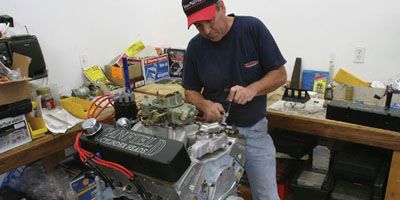
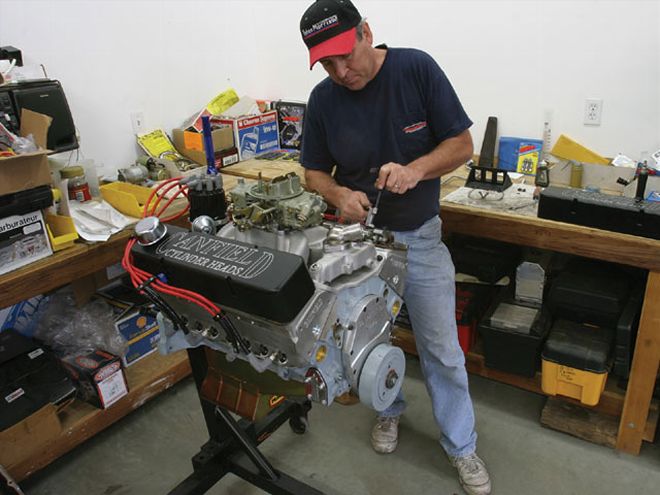 We built our 383 from a pile of parts, careful attention to clearances, and a little help from Competition Products and Canfield cylinder heads.
We built our 383 from a pile of parts, careful attention to clearances, and a little help from Competition Products and Canfield cylinder heads.
Last month, we produced a giant section on everything you ever needed to know about building a 383 small-block Chevy. The only thing we didn't give you was the buildup itself, because we ran out of room. So here is the engine buildup and dyno test of a typical street 383 that we built with a short-block kit from Competition Products, heads from Canfield, and an interesting flat-tappet mechanical from an upstart cam company called Camshaft Innovations.
The plan was, as always, simple: We wanted to make as much overall power as we could without spending a wad of cash. Our self-imposed rules limited us to no more than $10 per horsepower, so the push was to make as much power as possible, but also to be careful how we spent the rent money. The approach was a triple threat of pump gas compression, a great set of cylinder heads, and an aggressive camshaft. While we've built more powerful 383s than this engine and we've certainly built less expensive ones, we've never built one that made this much power while spending so little coin. The bottom line was a 475hp engine for much less than $10 per horsepower. Check it out.
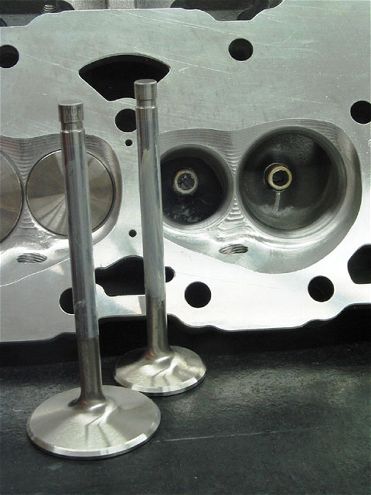 The Canfield 195 heads came with a 72cc CNC'd combustion chamber, a set of 2.02/1.60-inch stainless valves, and a nice set of dual-performance springs to make sure we had excellent control over the valves. The chamber size combined with the flat-top pistons resulted in an ideal 9.8:1 static compression ratio.
The Canfield 195 heads came with a 72cc CNC'd combustion chamber, a set of 2.02/1.60-inch stainless valves, and a nice set of dual-performance springs to make sure we had excellent control over the valves. The chamber size combined with the flat-top pistons resulted in an ideal 9.8:1 static compression ratio.
Torque Time 383
If you took all the new crate engines and stacked them up into one big pile, you'd see that many of them sell for roughly the same price as our budget on this 383. The problem is that most of those engines hover around 350 to 400 hp. Our fiscally responsible 383 twirled the horsepower meter past 475 for the same wad of cash. All you have to do is assemble it. We started with a very affordable Competition Products 383 rotator package that relies on a cast, two-piece rear main seal crank, stock 5.70-inch rods with ARP bolts, and Speed-Pro hypereutectic pistons. We rounded up a good 350 block that JGM cleaned and machined with a 0.030-inch overbore, and after a careful assembly, we had a reliable 9.8:1-compression short-block ready for the rest of the power equation.
We employed the Competition Products catalog again to choose a Howard's flat-tappet hydraulic cam with a reduced base circle to help connecting-rod clearance. We also decided to go with a pair of 195cc Canfield aluminum heads. Canfield owner John Fenton suggested a second cam from Jay Allen, who owns a company called Camshaft Innovations. Allen prescribed a more aggressive flat-tappet mechanical grind that appears at first to be a much bigger cam. However, it's not accurate to compare a flat-tappet mechanical cam with hydraulic cam specs even at the 0.050-inch tappet-lift numbers. The reality is that a mechanical cam includes a clearance ramp designed to use duration to gradually close up the hot lash clearance, which requires several degrees of duration to accomplish. A shortcut to make the comparison between hydraulic and mechanical cams more accurate is to subtract 1/2 degree of duration at 0.050-inch tappet lift for every 0.001 inch of valve lash. Given this cam's 0.016-inch lash spec, we subtracted 8 degrees from the 0.050-inch duration numbers. This places the Camshaft Innovation cam at 237 degrees at 0.050 rather than 245 degrees. Allen also designed the cam with a softer acceleration rate to accommodate a more aggressive 1.7:1 rocker-arm ratio. The more radical rocker ratio puts the gross lift close to 0.600 inch, which is roller cam territory at a flat-tappet cam price.
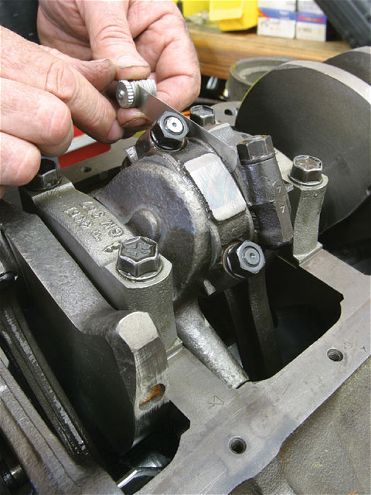 During the mockup phase of the buildup, a couple of the connecting rod pairs required minor filing to achieve the proper side clearance. The minimum rod side clearance is 0.008 inch with a range up to 0.015 inch. Excessive side clearance combined with a high-volume oil pump pushes more oil up on the cylinder wall, which can cause oil-consumption problems.
Flow Chart Canfield 195cc Heads Valve Lift Intake Exhaust E/I 0.{{{100}}} 61 51 83% 0.{{{200}}} 128 103 {{{80}}}% 0.{{{300}}} 191 143 75% 0.400 238 170 71% 0.500 271 189 70% 0.{{{600}}} 254 200 79% E/I – Exhaust-to-intake flow relationship in percentage
During the mockup phase of the buildup, a couple of the connecting rod pairs required minor filing to achieve the proper side clearance. The minimum rod side clearance is 0.008 inch with a range up to 0.015 inch. Excessive side clearance combined with a high-volume oil pump pushes more oil up on the cylinder wall, which can cause oil-consumption problems.
Flow Chart Canfield 195cc Heads Valve Lift Intake Exhaust E/I 0.{{{100}}} 61 51 83% 0.{{{200}}} 128 103 {{{80}}}% 0.{{{300}}} 191 143 75% 0.400 238 170 71% 0.500 271 189 70% 0.{{{600}}} 254 200 79% E/I – Exhaust-to-intake flow relationship in percentage
Dyno Time
With our 383 safely buttoned up, we tossed it in the back of our trusty GMC pickup and headed out to Westech's dyno. Steve Brul and crew bolted our externally balanced motor up on the SuperFlow 902, and we were ready to make some noise after bolting on a set of Hedman 13/4-inch dyno headers. We'll also come clean that we left the exhaust uncorked just so the power numbers would look better. If we had added a complete 21/2-inch muffled exhaust system, the power numbers would be more conservative by perhaps 10 to 15 hp.
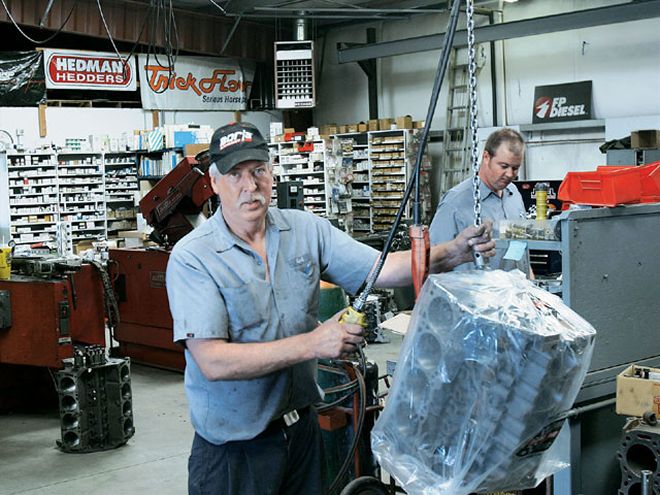 After installing the crank, rods, and pistons, we checked the position of the Howard's flat-tappet hydraulic camshaft. This was fortuitous because we discovered the cam was retarded by 3 degrees. The Competition Products adjustable timing set allowed us to advance the cam 4 degrees to position it 1 degree advanced.
After installing the crank, rods, and pistons, we checked the position of the Howard's flat-tappet hydraulic camshaft. This was fortuitous because we discovered the cam was retarded by 3 degrees. The Competition Products adjustable timing set allowed us to advance the cam 4 degrees to position it 1 degree advanced.
With the engine on the dyno, we spent some time pressure-lubing the engine by turning it every 90 degrees until we had oil into each of the 16 rocker arms. Using Shell Rotella T diesel oil for the added zinc and phosphorous to help the cam on its initial break-in, we also added a pint of Lucas Engine Break-In Additive for some extra insurance. Also, because removing the inner valvesprings to reduce the load on the lifters was not high on our to-do list, we opted to start the engine with a set of Comp Cams 1.3:1 break-in rocker arms. These rockers minimize the valve lift, which also reduces the valvespring load. Once we had about 25 minutes on the engine at between 2,500 and 2,800 rpm at a slight load, we made a pull on the engine with the 1.3:1 rockers just for grins. We were surprised that the 383 still managed to crank out a little more than 400 hp with barely 0.400 inch intake lift. Then, we swapped over to a set of the Scorpion 1.6:1 roller rockers to really get serious. Our first pull produced a surprising 461 lb-ft of torque and 439 hp from the conservative Howard's hydraulic flat-tappet cam. We followed that up with several pulls that netted almost identical power curves, which showed us that the engine was very repeatable.
Next, after a short cooling-off period, we took advantage of the Comp Cams two-piece timing chain cover to quickly remove the Howard's cam and replace it with the mechanical Camshaft Innovations grind. After we once again ran through the entire flat-tappet-cam break-in procedure, including the 1.3:1 rockers, it didn't take long for the new cam to push the power peak up to 471 hp. That's when we added a 1-inch carb spacer to the Edelbrock intake that delivered an excellent 477 hp at 6,100. What was also impressive was how the power curve around peak horsepower remained almost flat right out to 6,500 rpm. This may mean there is a minor cork somewhere that, once uncovered, could produce even more peak horsepower. Plus, the engine sounded happy right up to 6,500 rpm, which means the valvetrain was completely stable with no valve-float issues despite the 1.7:1 rocker ratio. The new Cam Innovations grind also broadened the powerband to a respectable 1,600 rpm between peak torque at 4,500 and peak horsepower at 6,100 rpm. If we include the power at 6,500 rpm, the powerband swells to 2,000 rpm! The mark of a strong street engine is one with the widest spread between peak torque and peak horsepower. This increases the engine's overall average power and drastically improves its acceleration potential.
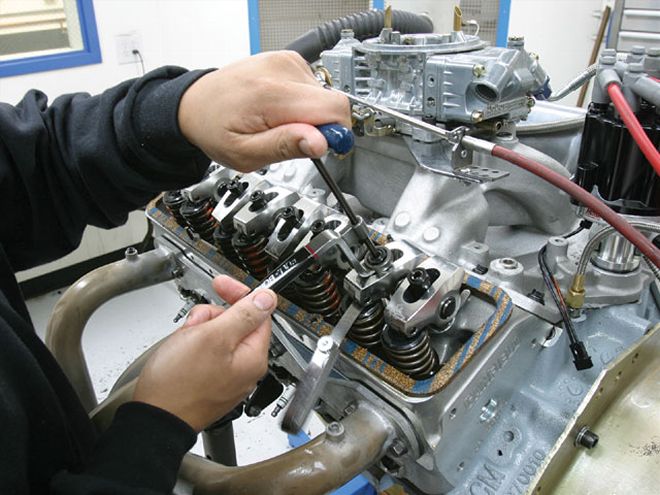 Dyno test 2 used the Camshaft Innovations mechanical flat-tappet cam with a steeper 1.7:1 rocker ratio and the suggested 0.016-inch lash. This stout rocker ratio accelerates the valve very quickly, which means it might float the valves sooner than a 1.6:1 ratio, but that extra lift definitely pumped the torque and horsepower all the way to 6,500 rpm.
Dyno test 2 used the Camshaft Innovations mechanical flat-tappet cam with a steeper 1.7:1 rocker ratio and the suggested 0.016-inch lash. This stout rocker ratio accelerates the valve very quickly, which means it might float the valves sooner than a 1.6:1 ratio, but that extra lift definitely pumped the torque and horsepower all the way to 6,500 rpm.
Westech's Steve Brul commented that with a few more tweaks, such as experimenting with lash and some lightweight synthetic race oil, we might be able to squeak 485 hp out of this combination. Of course, that's like dangling a carrot in front of a donkey, and now we're thinking about what it would take to push this budget Mouse up to 500 hp. But even at 475 hp for less than $4,750, it's hard to find fault with either the power or the price.
TEST 1 TEST 2 RPM TQ HP TQ HP 2,500 375 179 345 {{{164}}} 2,700 374 192 348 179 2,{{{900}}} 381 210 356 197 3,{{{100}}} 398 235 375 221 3,{{{300}}} 417 262 398 250 3,500 434 289 416 277 3,700 445 313 435 306 3,900 451 335 447 332 4,100 458 357 458 357 4,300 460 377 464 380 4,500 461 395 467 400 4,700 459 410 466 417 4,900 452 421 464 433 5,100 443 430 461 448 5,300 434 438 454 458 5,500 419 439 445 466 5,700 403 437 434 471 5,900 389 437 423 475 6,100 410 477 6,300 396 475 6,500 383 474 Peak 461 439 467 477 Averages 425.2 345.8 426.4 350.7 DESCRIPTION PN SOURCE PRICE Used 350 cylinder block used Junkyard ${{{100}}}.00 CP balanced 383 rotator kit 383F30 Competition Products 732.95 Howard's hydraulic cam 112591-S Competition Products 119.95* Howard's hydraulic lifters 91112 Competition Products 82.95* Camshaft Innovation cam Call Camshaft Innovation 249.00 Howard's solid lifters 91115 Competition Products 69.95 Cloyes timing set C3023X Competition Products 18.95 Cam bolt set 8161 Competition Products 4.59 CP 5/16-inch pushrods 1710 Competition Products 99.95 Canfield aluminum 195cc heads 200CP Competition Products 1,129.95 Scorpion roller rockers, 1.6:1 SCP-2003 Competition Products 259.99* Scorpion roller rockers, 1.7:1 SCP-1026 Competition Products 274.99 ARP head bolts, 6 pt. 134-3601 Competition Products 59.99 ARP oil-pump drive 134-7901 Competition Products 14.99 ARP oil-pump stud 230-7001 Competition Products 5.99 ARP engine-accessory kit 534-9601 Competition Products 87.99 ARP balancer bolt 134-2501 Competition Products 21.99 Edelbrock RPM Air-Gap 7501 Competition Products 209.95 Aluminum valve covers 561302 Competition Products 67.95 Milodon oil-pan kit 31900 Competition Products 312.95 Competition Products timing tab 54960 Competition Products 2.59 CP brass freeze plugs P101B Competition Products 13.99 Pioneer external balancer HB400 Competition Products 59.95 Pioneer woodruff key set 839009 Competition Products 1.79 Competition Products dowel pin kit 350D Competition Products 5.95 Pioneer flexplate, 168 ext. FRA104 Competition Products 24.95 Proform ring comp. 67445 Competition Products 24.99 MSD plug wires, 8mm 31183 Competition Products 63.{{{90}}} Timing cover, chrome 54934 Competition Products 8.99 Fel-Pro gasket set 260-1000 Competition Products 41.99 Autolite spark plugs 3923 Local auto parts 16.00 Quaker State 10W-30 Local auto parts store 10.00 AC oil filter PF-25 Local auto parts store 5.95 *These parts are not included in the final cost Total (no carb, distributor, or headers) $3,743.17 MACHINE WORK $351.00 NEW PARTS Holley Street HP 750 82751 {{{Summit}}} Racing 519.95 Hedman 13/4-inch headers 68190 Summit Racing 149.95 MSD Ready-to-Run distributor 8360 Summit Racing 306.60 GRAND TOTAL $4,719.67 CAM SPECS DURATION DURATION LIFT LOBE (ADVERTISED) (AT 0.050) SEPARATION CAMSHAFT Howards hydraulic, intake 292 230 0.467** 112 Flat-tappet, PN 112591-S*, exhaust 298 {{{240}}} 0.495** Camshaft Innovations, intake 294 245 0.603*** 109 Flat mechanical, exhaust 308 256 0.593****S = small-base-circle cam to clear the stock-length connecting rods** These published lift numbers are based on a 1.5:1 rocker ratio. With a 1.6:1 ratio, gross valve lift is 0.498 inch intake and 0.528 inch exhaust.*** These gross valve-lift figures are based on a 1.7:1 rocker ratio, which do not take into account subtracting 0.016 inch of lash, creating a net intake valve lift of 0.587 inch and exhaust of 0.577 inch.